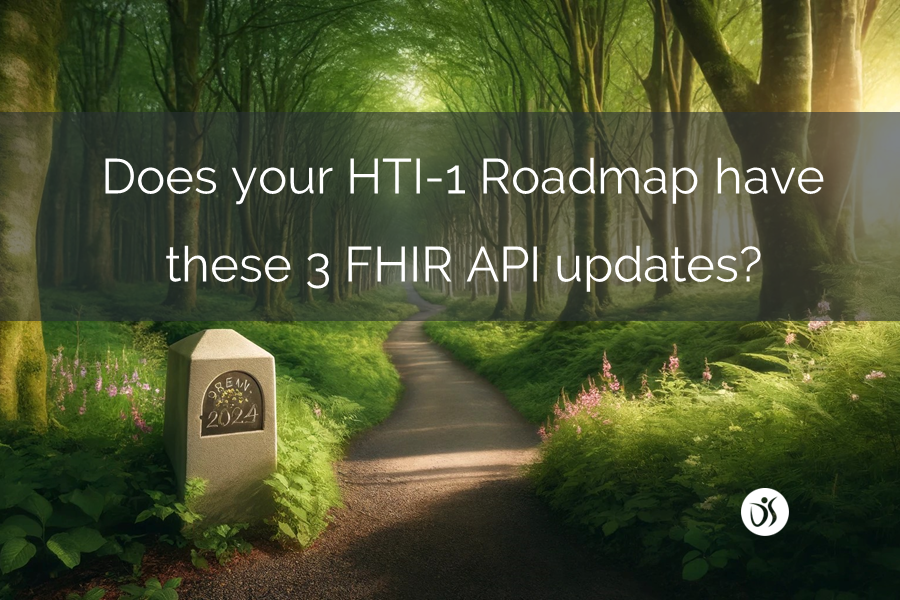Does your HTI-1 Roadmap have these 3 FHIR API updates?
It’s official! The Health Data, Technology, and Interoperability (HTI-1) Final Rule was enacted on March 11, 2024, marking a significant advancement in healthcare data interoperability and technology. It builds upon the foundations of the 21st Century Cures Act, aiming to enhance the sharing and accessibility of health information through FHIR APIs. It also emphasizes interoperability by introducing stricter data sharing, privacy, and security requirements for health IT developers. Additionally, it seeks to minimize information-blocking practices, thus facilitating a more open, patient-centered, and connected healthcare ecosystem.
As the healthcare industry evolves, so do the regulations. The introduction of the Health Data, Technology, and Interoperability final rule (HTI-1) brings about revisions to the EHR Certification program, underscoring the need for up-to-date compliance advice and support. Rest assured, we will be there to guide you through the intricacies of HTI-1 to ensure you're prepared and ahead of the curve.
Now, let’s take you through the highlights of the HTI-1 program. For the HTI-1 program, an EHR or a certified health IT module must meet the following three requirements:
EHR developers who want to retain the Base EHR certification must publish their Service Base URLs related to the (g)(10) FHIR API by Dec 31, 2024.
EHR developers need to upgrade the (a)(9) Clinical Decision Support (CDS) criterion to the new (b)(11) Decision Support Intervention (DSI) criterion by Dec 31, 2024, is also mandatory to retain the Base EHR certification.
Satisfy Conditions and Maintenance of Certification on an ongoing basis for (g)(10) and (b)(11) by Jan 1, 2026.
Now let’s dig deeper into each of these three requirements. It’s important to note that the EHR developers can achieve/maintain their Base certification by incorporating a relied-upon third-party software application.
1. Publish FHIR API Service Base URLs by Dec 31, 2024
With HTI-1, ONC has signaled its intent to enforce the § 170.315(g)(10) FHIR APIs to the full extent. Many EHRs assumed they fulfilled the (g)(10) compliance by December 31, 2022, if they could check the box on their CHPL listing. This resulted in cursory postings of API documentation and Service Base URL lists and inclusion in RWT Plans and Results even if they were not live. However, when multiple RWT results described the inability to test the FHIR-based API process in the wild, EHRs needed to conduct mock testing, similar to what was demonstrated during the certification process with their ONC-Authorized Testing Bodies (ATB). Since then, ONC has been actively conducting an awareness campaign to inform health IT developers of the need to publish and maintain their FHIR Service Base URLs.
“By December 31, 2024, Certified API Developers must publish their customers’ Service Base URL information (FHIR Endpoints) according to specific adopted standards”
Quarterly review and update of FHIR endpoints: The HTI-1 final rule states that the FHIR API developers must review FHIR endpoints and organization resources quarterly and update the information as necessary. The rule noted that the one-time publication of the developer’s current list of endpoints for active customers upon certification to the § 170.315(g)(10) criterion would only meet initial certification requirements. Certified API Developers must keep this information up-to-date over time. Failure to maintain the Service Base URLs and the associated organization information error-free on a quarterly basis would be considered a violation of the Conditions and Maintenance of Certification requirement and may result in corrective action. If any FHIR endpoint or organization information is out of date, incomplete, or otherwise unusable for more than 90 days, it would be considered a violation of this requirement.
Lantern listing: ONC is already assessing Service Base URL compliance with Lantern, an open-source tool to query FHIR API endpoints to monitor their availability and determine health IT Developers’ URL status. Out of the URLs that are discovered and monitored by Lantern for FHIR version 4.01, Darena Solutions has the most extensive URL listing. The Service Base URLs for our EHR clients are published as soon as they a placed in production after they integrate with our ONC-Certified BlueButtonPRO application, the first in the country to certify to the § 170.315(g)(10) criterion.
NOTE: The ONC deadline is Dec 31, 2024. Each ONC-ACB will have deadlines from late November to the first week of December. Darena Solutions already satisfies this ONC mandate.
2. Upgrade to (b)(11) Decision Support Interventions (DSI) criterion by Dec 31, 2024
As per the HTI-1 final rule, EHRs currently certified to the (a)(9) Clinical Decision Support criterion must upgrade to the (b)(11) Decision Support Interventions criterion requirements and provide the updated certified health IT to their customers by the end of 2024. EHRs and Health IT vendors will be required to meet the “Base EHR” definition starting January 1, 2025.
Accomplishing this update involves navigating through a web of intricate processes. It's not just about quick revisions or pointing to new references but about integrating with existing systems and maintaining regulatory compliance. EHRs must analyze the impact on workflows and update user training for the new features. Each of these steps requires meticulous planning and execution. Despite that, the transition may uncover unforeseen challenges requiring additional problem-solving. In short, upgrading from (a)(9) to (b)(11) is a multifaceted endeavor that demands attention to detail and a comprehensive understanding of the revised criterion. We’ve covered details in a separate blog focused on the Decision Support Intervention (b)(11) criterion.
3. Meet Conditions and Maintenance of Certification for (g)(10) and (b)(11) by Jan 1, 2026
One of the first deadlines that has been mandated by the HTI-1 final rule builds on the (g)(10) FHIR API requirement established under the Cures Act. Only checking the box for (g)(10) FHIR API or declaring no interest on the part of providers to use the APIs will not preclude an EHR from meeting the Conditions and Maintenance of Certification requirements.
If a health IT developer has a Health IT Module certified to § 170.315(g)(10), then the health IT developer must submit responses regarding:
The number of requests for each certified health IT deployment that returned FHIR® resources.
The number of distinct certified health IT deployments active at any time.
The number of distinct deployments active at any time that returned FHIR resources in response to API calls from apps connected to certified health IT. These responses need to be further stratified by:
User type
FHIR resource
US Core Implementation Guide version
HTI-1 Readiness Checklist
Here is a checklist to help assess your EHR development team’s HTI-1 readiness:
Has your EHR development team outgrown the initial “check-the-box” § 170.315(g)(10) solution as it doesn’t meet the production requirements or the FHIR API URLs?
Does your development team -
Need an easy-to-use FHIR API and sandbox for testing - something like Swagger?
Require C-CDA to FHIR conversion help (including ePHI) up through USCDI v3?
Need a hosted FHIR Server?
Need help with automatically posting and quarterly maintenance of your Service Base URLs?
Need to facilitate the patient invite and authentication process?
Need to validate the connection to third-party apps?
Need support for keeping the Conditions and Maintenance of Certification updated annually?
Need help with staying compliant with annual Real-World Test plans and results requirements?
While the Dec. 31, 2024 deadline may appear distant, the steps to ensure compliance should be initiated immediately. If you checked more than one item on the list above, you should seriously evaluate outsourcing all the recurring items to a team of reliable experts and move them off the task list of your development team.







